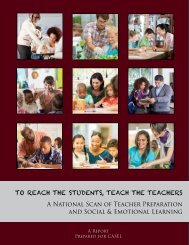Future Ready Learning
7m3sdJ
7m3sdJ
You also want an ePaper? Increase the reach of your titles
YUMPU automatically turns print PDFs into web optimized ePapers that Google loves.
3. Provide students with feature-rich educational devices that are price competitive<br />
with basic textbooks<br />
4. Empower students with digital learning content and experiences aligned with<br />
college- and career-ready standards being adopted and implemented by states<br />
across America<br />
WhiteHouse.gov has more information on ConnectED. For guidance on how these<br />
goals are being operationalized, see the U.S. Department of Education’s <strong>Future</strong> <strong>Ready</strong><br />
Schools: Building Technology Infrastructure for <strong>Learning</strong> and the White House’s<br />
ConnectED resources.<br />
<strong>Future</strong> <strong>Ready</strong> Leaders<br />
To help support leaders’ move toward creating the technical infrastructure and human capacity<br />
necessary to fully implement this vision for transformative learning enabled by technology, the<br />
U.S. Department of Education partnered with the Alliance for Excellent Education and more than<br />
40 other partner organizations to launch <strong>Future</strong> <strong>Ready</strong> in November 2014. The department also<br />
challenged superintendents to indicate their commitment to transform teaching and learning in<br />
their districts by signing the <strong>Future</strong> <strong>Ready</strong> Pledge. To review the <strong>Future</strong> <strong>Ready</strong> Pledge and see<br />
which districts have signed, visit http://www.futurereadyschools.org/take-the-pledge.<br />
<strong>Future</strong> <strong>Ready</strong> Focus Areas<br />
Selected by synthesizing the best available research and practice knowledge, the four focus areas<br />
of <strong>Future</strong> <strong>Ready</strong> are collaborative leadership, personalized student learning, robust infrastructure,<br />
and personalized professional learning. 3<br />
Collaborative Leadership<br />
• Education leaders develop a shared vision for how technology can support learning and<br />
how to secure appropriate resources to sustain technology initiatives. Leaders seek input<br />
from a diverse team of stakeholders to adopt and communicate clear goals for teaching,<br />
leading, and learning that are facilitated by technology. They model tolerance for risk and<br />
experimentation and create a culture of trust and innovation.<br />
• Leaders communicate with all stakeholders by using appropriate media and technology<br />
tools and establish effective feedback loops. While implementing the vision through a<br />
collaboratively developed strategic plan, leaders use technology as a learning tool for both<br />
students and teachers. Leaders are creative and forward thinking in securing sustainable<br />
streams of human and capital resources to support their efforts, including appropriate partnerships<br />
both within their institutions and beyond.<br />
OFFICE OF Educational Technology<br />
40



